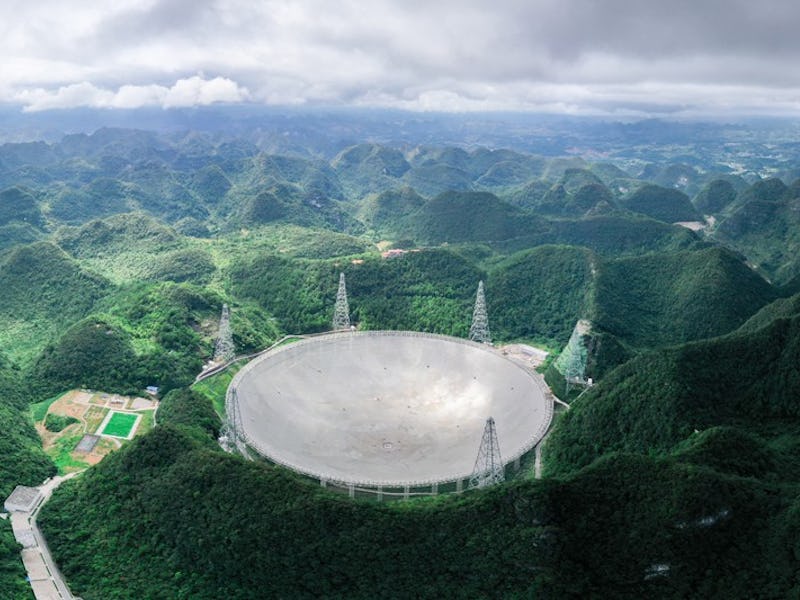Can a Chinese telescope find self-replicating alien probes?
Set to become the world's largest radio telescope, FAST may be able to find aliens.

Zaza Osmanov, a physics professor at the Free University of Tbilisi, Georgia, wants to find mischievous, self-replicating probes built by a hyper-advanced alien civilization.
“The self-replication itself will inevitably lead to the exponential growth of the swarm of probes, making the process of space exploration very efficient,” Osmanov tells Inverse.
But these probes may not be so easy to find as they may be as small as a millimeter floating in the depths of space. In order to catch them in action, Osmanov suggests turning to the world’s largest radio telescope, which has its gigantic eyes set on the cosmos in search of alien life.
Launched in January 2020, China’s Five-hundred-meter Aperture Spherical radio Telescope (FAST) is on the hunt for radio signals possibly being transmitted by intelligent extraterrestrial life. And now, Osmanov suggests that FAST may even be able to find these self-replicating probes.
The work is detailed in a study available on the pre-print server Arxiv.
What is a von Neumann probe?
In 1966, Hungarian-American mathematician and computer scientist John von Neumann proposed that the most effective way of space exploration would be to design self-replicating robots.
A hyper-advanced alien civilization would be able to build a self-replicating swarm of robots to explore the depths of space.
These robots would seek out raw material from asteroids or moons, and even entire planets, to create copies of themselves. These replicas would continue in their quest across the cosmos, traveling from one star system to the next.
It is the same way that bacteria travels on Earth, which is why it has been suggested that von Neumann probes may actually be considered as a form of artificial life.
Who can build a von Neumann probe?
Building a Von Neumann probe would require developing a type of artificial intelligence that human society is far from achieving. Only an advanced alien civilization may be able to build a von-Neumann probe.
The Kardashev scale was developed by astrophysicist Nikolai Kardashev in 1964. It measures how far technologically advanced a hypothetical alien civilization is based on the amount of energy it consumes.
The scale has three types of civilizations:
- Type I civilization, which uses the energy available to it on its planet
- Type II civilization, one that consumes as much power at the scale of its entire star system (meaning its host star and the other planets that orbit it)
- Type III civilization, the most advanced kind which can harness as much energy as the entire galaxy
The human civilization is not even a Type I civilization yet. Instead, we’re currently at 73 percent where we need to be, according to the Kardashev scale. It would take at least a Type II civilization to have the resources to design von Neumann probes
“[The human civilization] can achieve Type-II in approximately 3,000 years if 1 percent of annual growth of industry is maintained,” Osmanov says.
Needless to say, we are far from being able to build one of these self-replicating probes.
How would we detect a von Neumann probe?
According to Osmanov, it’s possible for von Neumann probes to colonize an entire nebula (a giant cloud of gas and dust bustling with stars) thanks to an abundance of material to consume.
The replication process of the swarm of probes requires collecting material in nebulae, or other interstellar objects, which consist of hydrogen. As each individual molecule is captured by the probes, it will be ionized and will then radiate.
Therefore, an entire swarm of probes will produce emissions in the form of radio signals and X-rays.
“Self-replicating probes will be characterized by a certain technosignature,” Osmanov says. “Since the number of robots should exponentially increase, the generated total luminosity will be exponentially amplified in very short time-scales, reaching stellar luminosities in several years.”
How FAST can detect von Neumann probes
Osmanov suggests using the FAST radio telescope to hunt for these probes.
FAST was built into the Dawodang depression, a natural basin in Pingtang County, Guizhou, southwest China.
The 500-meter wide dish is made up of around 4,400 individual aluminum panels that focus on different areas of the sky.
The telescope’s sheer size means that it can detect extremely faint radio-wave signals from across the universe. It detects radio frequencies from 70 megahertz to 3 gigahertz, and von-Neumann probes would emit frequencies within this range.
“The high sensitivity of the telescope makes the search for von Neumann probes very prospective,” Osmanov says.
Abstract: In the present paper we consider the Type-2.x and Type-3.x extraterrestrial von-Neumann probes and study the problem of their detectability by the world’s largest radio telescope: the Five-hundred-meter Aperture Spherical Radio Telescope (FAST). For this purpose we estimate the radio spectral parameters and analyse the obtained results in the context of technical characteristics of FAST. As a result, it is shown that FAST can detect as galactic as well as extragalactic self-replicating probes with high precision.